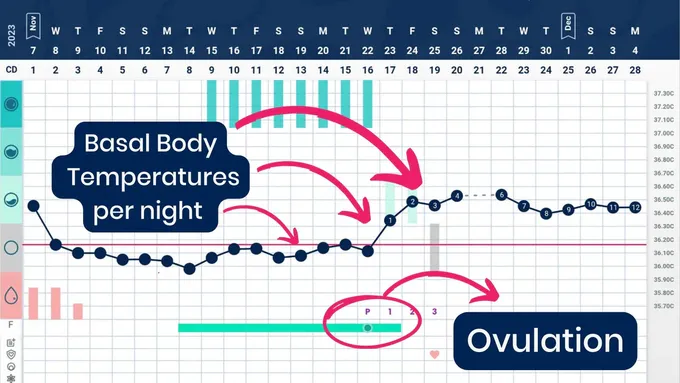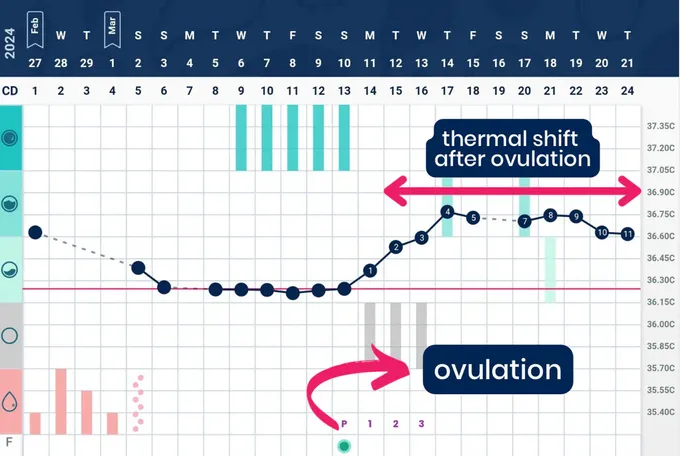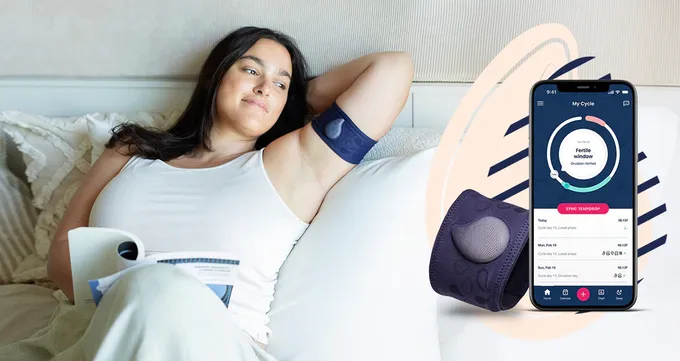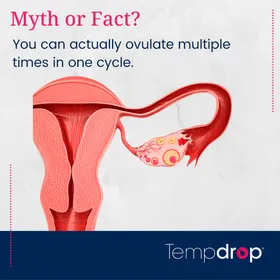Basal Body Temperature: The Fertility Indicators That Count
Published February 5, 2025.

At Tempdrop, we talk about the importance of basal body temperature (BBT) all the time, so much so that sometimes we take it for granted! In this blog post I want to touch on the importance of basal body temperature, and the various ways basal body temperature can be a window into your cycle as well as your overall health.
While charting basic cycle days can give you some great information as to what might be going on hormonally, tracking your basal body temperature is like revealing a whole new layer.
Many charting apps estimate the time of ovulation based on the notions we all ovulate on day 14, and we all have regular length cycles. This just isn’t the case! The day of ovulation is unique to each woman and cycle, and by charting basal body temperature we can see in someone’s chart whether or not they ovulated.
The Connection Between Ovulation & Basal Body Temperature
The rise and fall of hormones each cycle is what makes charting your cycle so fun and fascinating.
- Cycle day 1 is the first day of full bleeding.At menstruation (the beginning of your cycle), hormone levels are very ow, and they only begin to climb as ovulation approaches. Leading up to ovulation (or the time that an egg is released), estrogen reaches its peak, triggering luteinising hormone to release the egg.
- Following ovulation, your dominant hormone becomes progesterone.
- Progesterone has a whole host of health benefits aside from nurturing a potential fertilized egg. Progesterone calms anxiety and boosts sleep, and maintains cells such as bone and brain cells. Progesterone has an effect on metabolism meaning that your basal body temperature (lowest body temperature attained during rest) rises very slightly.
This is what we measure when we track basal body temperature - that very slight rise in temperature that indicates ovulation has taken place.
Using BBT to conceive is one piece of the puzzle
Progesterone rises after ovulation, and we see this in someone’s chart with what is called a temperature shift. Temperature rises very slightly, and using a basal body thermometer like Tempdrop we can see the shift and know that ovulation has happened. However, we can never predict when ovulation will happen. This is because the time between menstruation and ovulation (the follicular phase) varies due to individual differences, stress, travel, life changes, diet changes or anything else going on in your body or environment. Knowing how to track other fertility signs will give you a clearer picture as to when ovulation is approaching.
BBT as a window into your health
Ovulation is a key indicator of your overall health. Whether you ovulate each month or not will give you a very clear picture of your hormonal health. If your overall health is compromised, your body may put ovulation on the backburner. Most people won't know whether they’re ovulating or not unless they’re charting their cycles. You can assess your own health by tracking ovulation, and use your charts to address the root cause of any health issue with a women’s healthcare provider.
How do I know I've ovulated with BBT?
Basal body temperature will rise very slightly after ovulation, due to the presence of progesterone. Usually there will be a very clear range of temperatures before ovulation, and a clear range of temperatures after ovulation.
In Sensiplan, which is one method of fertility awareness - there are many others*, you are looking for one high temperature above the previous six days to indicate likely ovulation. You can confirm ovulation with your temperatures when you have three temperatures higher than the previous six.
*I recommend if you're wanting to learn more about how to chart your cycles and use a fertility awareness method, that you reach out to a certified instructor.
BBT plus other fertility indicators
Basal body temperature will only tell you ovulation has happened after the fact. To get a clearer picture of your fertile window, or when ovulation is approaching, incorporating other fertility signs is key. In the symptothermal method of fertility awareness, we track both BBT and cervical mucus. There are other additional signs of fertility as well, such as cervical position, LH tests or OPKs, and cervical mucus.
As a fertility awareness educator, I don’t recommend using basal body temperature alone. The Symptothermal fertility awareness is effective as birth control when using both cervical mucus and temperature.
Basal Body Thermometers
You can track your basal body temperature with an oral thermometer, as long as it reads to the hundredths of a degree. Some people are able to find these at the drugstore, or there are thermometers with more features available online. When taking your temperature with a basal body thermometer, ensure you’re taking it at the same time every day, before you get out of bed. You can take it orally, in the “pocket” on either side of your tongue, or you can take it vaginally - just ensure you stick with the same one for your whole cycle.
If getting up at the same time every day is an issue for you, I recommend using Tempdrop. Tempdrop allows you to wake up at any time and still get an accurate basal body temperature reading.
Basal body temperature is one piece of the puzzle when it comes to tracking your fertility. With basal body temperature, you’re able to see clearly when you ovulate and have a better picture of your overall health!
If you'd like to learn more about FABM, including how to chart your cycle and identify your fertility window, download Tempdrop's free Starter Guide to Fertility Awareness or access the Tempdrop Academy from the app.








